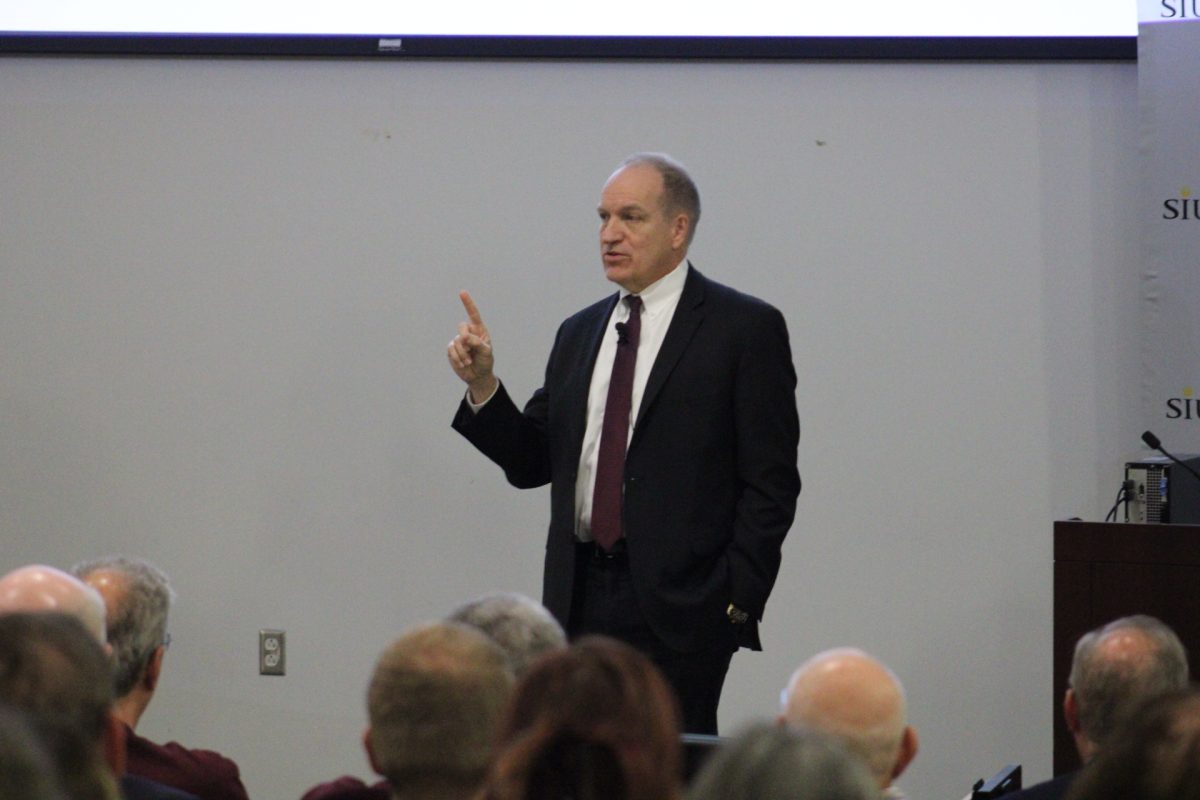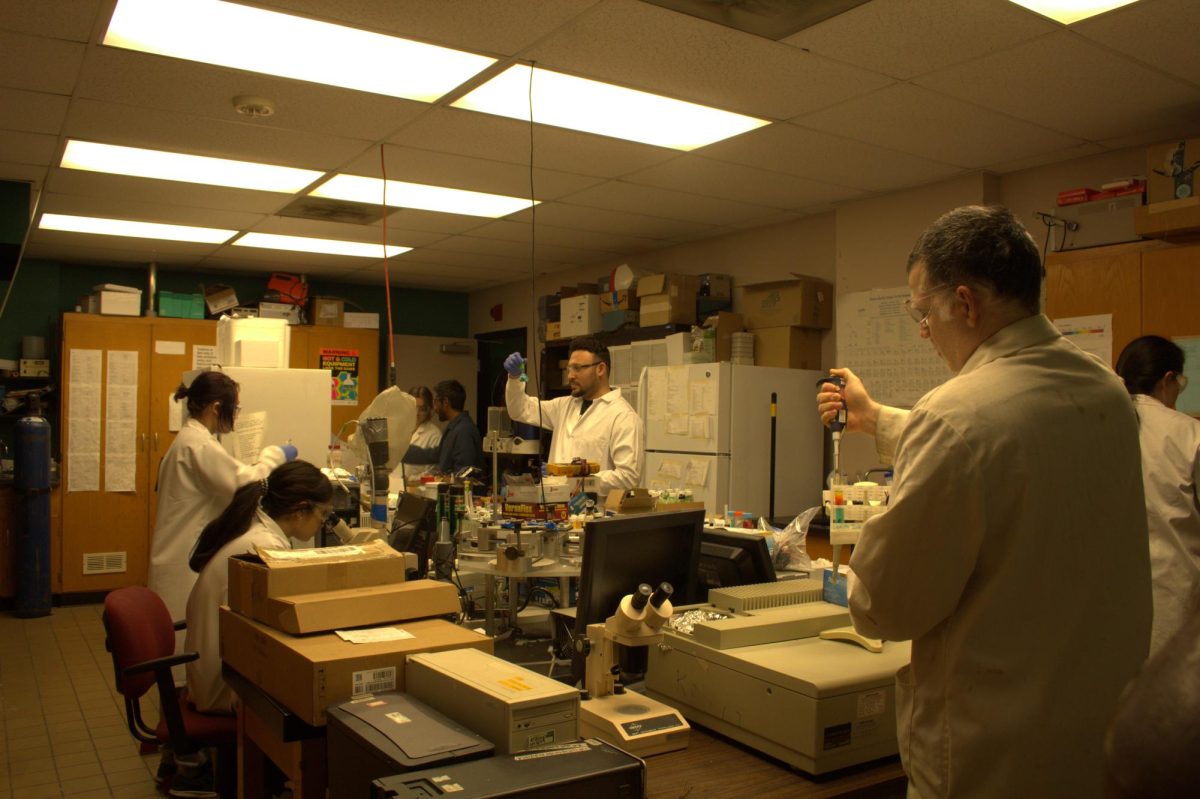Southern Illinois University System President Dan Mahony gave a presentation on college enrollment trends and strategies on Friday at SIU’s Carbondale campus.
While Mahony noted that nothing he was presenting was new information, meaning that it had been previously published in some other SIU material, he stressed the need for a “common understanding of where we’ve been, where we’re at and where we’re heading.”
“Enrollment is critical to our future,” Mahony said. “We must grow enrollment, and it is more challenging than it has ever been.”
Advertisement
One of the main reasons that enrollment is important to a university is because of the money that it brings in. The money that is made helps to fund salaries, improve and construct campus facilities, and to continually improve the curriculum.
Mahony began his presentation by talking about how enrollment used to be at colleges, citing a 25% increase in enrollment from 1998 to 2011. While enrollment increased, Mahony pointed out that state appropriations, or funding from the state for public universities, began to drop around 2000.
“We went down about 25% in state appropriations from 2002 to 2019,” Mahony said. “If you do a present value analysis… it’s about 50%. We lost about half of our state appropriation over that 17-year period.”
Mahony went on to note that it wasn’t unusual to lose that much in appropriations based on national trends. Capital funding, which essentially provides funding for construction projects, also decreased significantly.
The decrease in capital funding has been a large part of why there have been very few buildings or renovations done within the SIU system. The money that does exist is going towards maintaining current buildings, which continue to be expensive.
Mahony explained that when these buildings were constructed, there wasn’t much money put into a deferred maintenance account because lawmakers and schools trusted that they would continue getting the same amount from the state for facility improvements.
When capital funding decreased, it left campuses with many old buildings that needed to be maintained. Though they could afford to maintain the buildings, it meant that there wasn’t much money left to construct new ones.
Advertisement*
Mahony said, “What this means is that tuition revenue becomes much more critical because of state appropriations going down. So what we start to see is tuition increases combined with enrollment growth.”
The increase was dramatic; according to Mahony, from 2005-2011, the average increase in tuition was 10% yearly.
The demand for college was high. Institutions, because they didn’t have state appropriations, weren’t afraid to increase their prices because they knew students would keep coming.
2011 marked a year of changes: there were fewer students coming out of high school, and the graduates that were coming out weren’t as likely to go to college.
Mahony mentioned this was the time period when there was a big separation between the enrollment at flagship universities, such as Clemson and the University of South Carolina, and schools such as SIU. The flagship universities adapted their enrollment goals in order to increase and to get the money to continue their improvements, while smaller schools like SIU essentially stagnated because they had the same enrollment.
From 2010 to 2019, enrollment at SIU schools suffered. At Edwardsville, enrollment dropped 14%, while Carbondale plummeted 43%. Statewide, enrollment dropped 34%. This drop left structural deficits in most budgets.
“We are not designed to cut budgets quickly. Most of our costs are in personnel… and that deferred maintenance just gets a whole lot worse,” Mahony said.
SIU also drastically reduced tuition increases. From 2016 to 2022, tuition increased less than 2% annually, including during the budget impasse for fiscal years 2016 and 2017.
Mahony then presented a list of strategies that would help enrollment continue to increase in the Southern Illinois University System. Included on the list were improving retention, improving the transition from community college to SIU, making the best use of financial aid dollars, recognizing the changing demographics in recruitment and growing programs for populations that are not being adequately served.
Mahony said he and several other administrators visited Georgia State, which has a similar student population, to talk about retention.
“They said, ‘when you’re trying to increase retention, you’re always going to get this response. Nothing is going to work until we do x,’” Mahony said. “They said, ‘do something. Do the thing that you can do most quickly, have success with that, and then build to the next one.’”
Mahony discussed how financial aid dollars are able to be better distributed, including mentioning a tuition break for lower-income families.
The Saluki Commitment states that, among other requirements, students whose families make less than $103,000 per year are able to come to SIU free of tuition and mandatory fees.
The demographics of the students that are receiving these financial aid dollars is also changing, and Mahony said realizing this change is important for universities. The majority of students under 18 are not White anymore, and this is showing up in the students that are coming to universities.
“Overall, White enrollment was down about 1%; in contrast, Black, Latinx and Asian enrollment was all up, somewhere between 2% and 4%,” Mahony said.
There are also increases in enrollment among populations like adults who either didn’t go to college, left, or need to come back. These students may be coming back to receive new degrees, certificates or credentials.
“Graduate certificate programs were up 5.6%, and undergraduate certificate programs were up 9.9% this year. So much more growth in those than in traditional degree programs,” Mahony said.
Some of these adults may be taking classes online, which is something that the Southern Illinois University System is focusing on to help make itself more competitive.
“The last couple years, as a system, we’ve been working on the SIU System online, which is a collaboration between the Edwardsville and Carbondale campuses to create programs that will be available to students online, but you can take classes from any of the schools within the system,” Mahony said.
Mahony closed his presentation by reiterating that none of these ideas were new; they were all included in previous strategic plans that various SIU employees had a hand in. He also said he thought it was important to “communicate as openly as possible about what we’re doing, why we’re doing it, so people can understand what is going on across the system. And frankly, we need widespread commitment across the system.”
Staff reporter Ryan Grieser can be reached at [email protected]. To stay up to date on all of your southern Illinois news, be sure to follow The Daily Egyptian on Facebook and Twitter @dailyegyptian.
Advertisement










